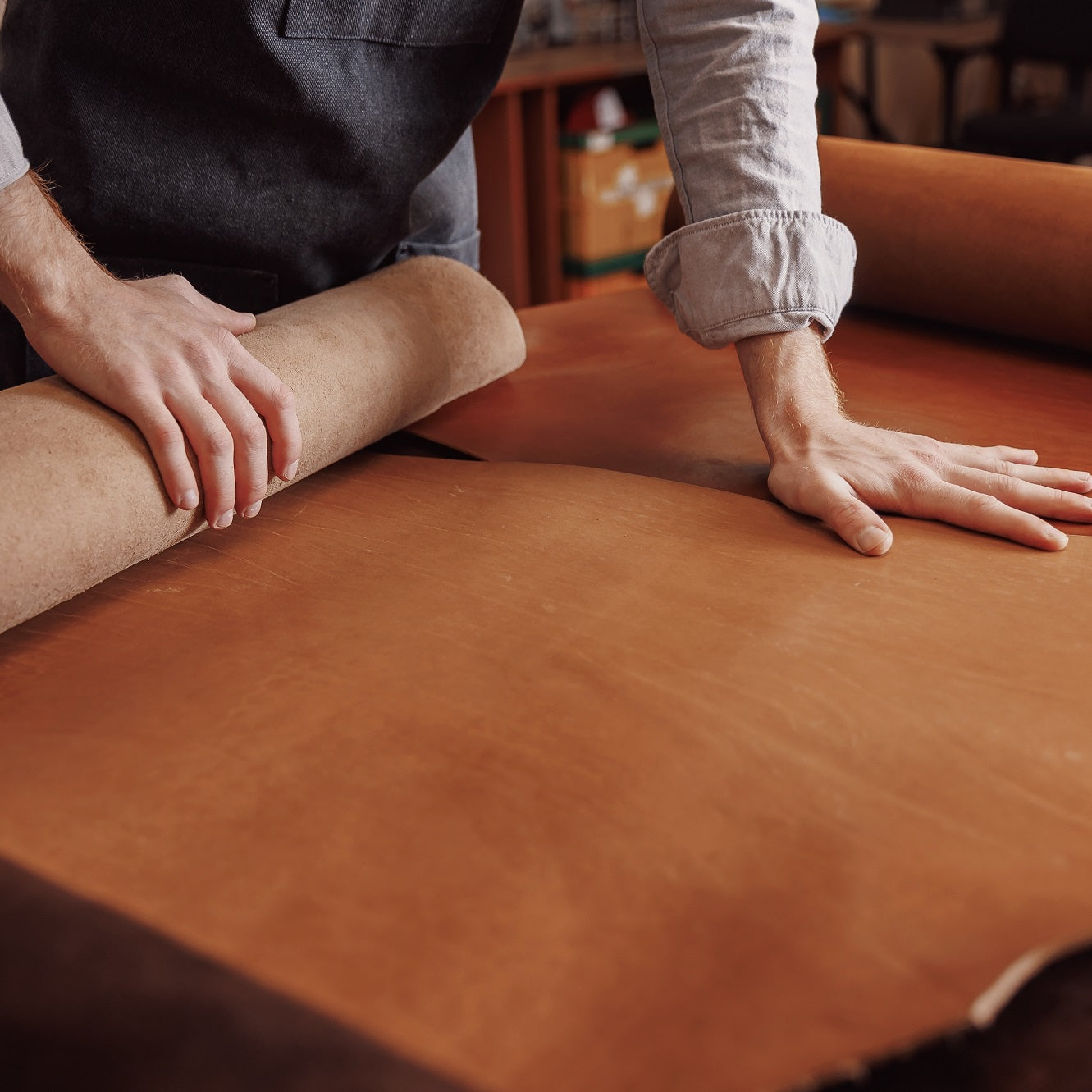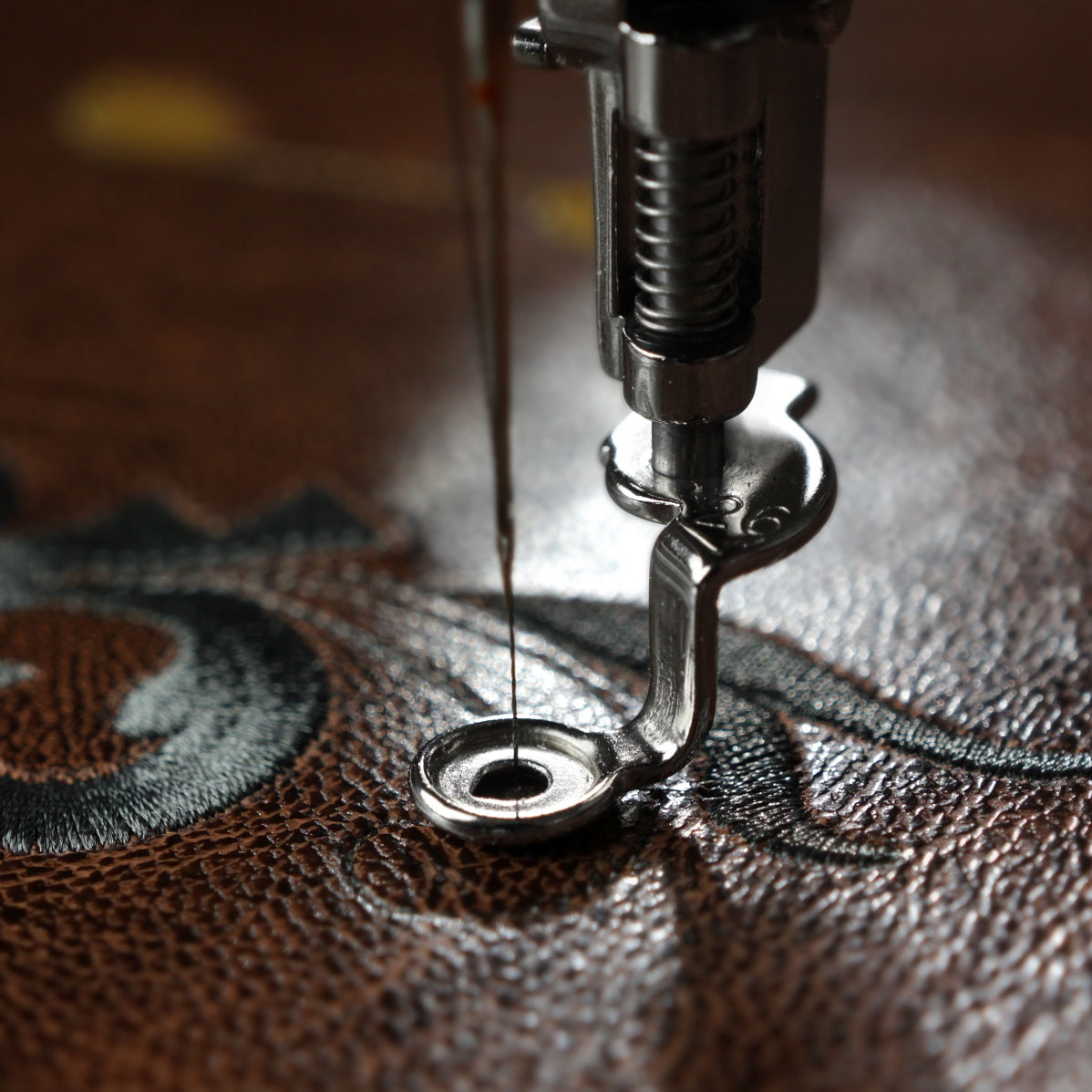All the terms you come across about leather finishes types may confuse you as a layman, so we are here to simplify it.
What is Leather Finishing?

The leather finishing process is a practice that defines the look of leather, mostly using dyes and chemicals. The main reason for applying a leather finish is to give the leather the desired color, shine, texture, strength, and durability. Finishing forms a protective barrier, saving the precious material from wear and tear.
Why is Leather Finishing Important?
What role does leather finishing play in leather crafting? How does the process impact the quality of leather?
The type of finishing used has a considerable influence on how the leather would be used. It can lighten or darken color or create a unique look, for example, in the case of an antique leather finish.
Apart from giving the leather its look, finishing is a protective coat, keeping the leather surface protected against water stains, scratches, and wear and tear related to humidity or temperature changes.
Different Types of Leather Finishes

Each type of leather finish gives a distinct aesthetic and level of protection to the leather. A particular finish considered suitable for a product may not be the right fit for another product. Before selecting one suitable for your leather product, you need to know about different leather finishes.
Aniline Leather Finish
Coming up first among all the varying leather finishes is the aniline finishing. Primarily a transparent, soluble dye, aniline is the most natural looking finish, letting the leather retain its natural look. All the characteristic marks are evident in the aniline-finished leather.
Only full grain leathers are qualified for the aniline finishing as sensitive leathers will be prone to wear and tear. However, it is not recommended for hard-wearing use as the absence of a top protective coat makes aniline leather vulnerable to damage.
Semi-Aniline Finish
Semi-aniline combines the soluble dyes used in the aniline finish and an extra top coat for protection. As it is more resistant to damage due to the top coat, semi-aniline leather is preferred by mass produced leather product manufacturers as well as artisans who make heavy-duty leather goods. Much like an aniline finish, semi-aniline shows the leather's natural grain but has a more even color.
Pigmented Full Grain Leather
Pigmented finishing, also known as a top coat, is a technique where the leather surface is treated with a heavy coat of pigments. Due to the heavy coat, the roughness of the leather is concealed, so pigmented leather finishing is often preferred for corrected grain leather.
Pigmented leathers are stain-resistant and durable, with the layer over leather, protecting it against general wear and tear.
Suede Leather

A popular choice for its splendid fuzzy nap, the suede finish is created by buffing the underside of the hide. Although the napped texture of suede is sought-after, this type of leather is more vulnerable to staining and damage.
Nubuck or Brushed Leather
Unlike suede, a nubuck leather finish is created by buffing the hide's top side (grain). As it is buffed on the grain side, nubuck has a smoother and finer texture than suede, as the collagen fibers are finer than corium. Also, nubuck-finished leather is slightly more durable than suede but similar in vulnerability to staining.
Nappa Leather

Nappa is a thin, soft, and smooth leather as compared to other types of finishings applied on leather.
Oil Leather or Pull-Up Leather
The type of finish where a significant amount of oil is applied to leather, making it more supple, is known as oil leather or pull-up leather. A characteristic quality of pull up leather is that it is lightened in color where you stretch, bend or pull it. Oil leather is water resistant and durable.
Apart from oil, leather can also be treated with natural wax finish to give it the same pull up quality and water resistance.
Neatsfoot Oil Finish
Neatsfoot oil is a commonly used finish to restore the softness of leather. Pure neatsfoot oil, made from feet and shins of bovine animals is proven to be a preservative as well. As it can leave a sticky residue that catches dirt, it is recommended to buff the leather with a soft cloth after applying neatsfoot oil.
Embossed Leather

Embossing on leather is a process in which patterns or designs are ingrained onto the leather using heat or pressure. Leather can be embossed by hand using metal stamps or by embossing machines that use heat to create the pattern. Embossing can give natural cow or sheep leather an appearance of exotic leathers, such as crocodile or snake leather.
Afterwards, a finishing dye or oil is applied to embossed leathers to protect them from damage. If you are embossing a leather product yourself, apply an oil to create a finished surface. You can use mink oil, or a very light coat of olive oil and buff it with a soft cloth. If you don't want to use olive oil or mink oil, you can also opt for lanolin oil.
Dry Milled Leather
Dry milling is a finishing process where leather is put in drums and subjected to rotation and heat. As a result, a pebbled texture is formed on the leather mimicking a lived-in appearance. The process also makes the leather much softer.
Antiqued Grain (Two-Tone Leather)
Leather which gives an aged appearance and a patina is highly sought after, but the natural process it undergoes is quite long. The quick fix to get a similar two toned look is to apply antique grain finishing on leather. It is a process where leather is subjected to fine grit sandblasting after applying a protective top coat and dyes so that a polished grain mimicking the natural patina is formed.
Patent Leather
Have you ever seen a leather product with a beautiful, highly glossy appearance? It is the patent finishing in which leather is given a shiny surface with the help of liquid resin, acrylic finishes, or plastic lamination. Patent leather goods, such as shoes and bags, give a feel of a high end, luxury product.
Burnishing Leather
Burnishing is a technique used by leather crafters where they apply gum or wax on leather edges and vigorously rub them with a burnishing tool. The pressure and heat created with constant rubbing cause friction that seals the edges by contracting the fibers. When the edges are burnished, the natural oils of the leather are retained.
Bicast Leather
Generally used on split leather, the bicast finishing is done by spraying polymer coating on the leather to form a protective layer. The polymer coat is applied several times as a thin layer. As bicast leather is a fusion of synthetic and natural materials, a special bicast protector is recommended to maintain it, as products specified for natural leather cannot be used on it.
Embroidered Leather

To give the leather a beautifully adorned look, embroidery is often used. Threadwork done in intricate designs enhances the appearance of leather. This finishing is either done by hand or machine, depending on the type of leather and the complexity of the design.
From simple initials and logos to murals and elaborate patterns around the edges or all over the product, the embroidered finish can add to the appeal of a product.
Faux Leather
As opposed to full grain leather and lesser grades of natural leather, faux leather has a uniform texture and look. However, it cannot match the durability of real leather.
Faux leather is made by applying vinyl or PU finish to a synthetic base, such as polyester, nylon, or rayon. It then undergoes the rolling press, where the grainy texture mimicking natural leather is applied to it. Faux leather is mostly used for upholstery and lesser priced garments.
Custom Leather Finish Options at Poshele
Made up your mind regarding the type of finish you want on your leather jacket? You don’t need to look elsewhere. At Poshele, we allow customers to choose their choice of leather finishes. You can opt for custom finished leather jackets, custom embossed leather jackets, embroidered finishing on jackets, protected aniline, or any type of finishing you desire.
FAQs
What is smooth leather called?
Nubuck leather, with its velvety soft nap, is often called smooth leather. Nappa finished leather and suede are also smooth and soft as compared to other types of leather finishing.
What is the most durable leather finish?
With its heavy coating and stain resistance, the pigmented leather finish is the most durable for leather. Semi aniline leathers are also considered significantly durable.
What is unfinished vs finished leather?
Leather not yet treated with a protective dye, sealing, or coating is termed unfinished leather. It is more vulnerable to staining and damage. In contrast, finished leather has a protective coating of different dyes and oils that provide color, stain resistance, and water resistance.
What is a shiny leather surface called?
Leather with a glossy finish is known as patent leather. The glazed appearance of leather is created with a layer of lamination, resin, or acrylic finishes.
Conclusion
Leather finishing is one of the most crucial steps in the leather manufacturing process as it decides the feel, appearance, and durability of leather. Different types of leather finishes are used to give the leather a degree of protection from wear and tear and desired color and textures. You can opt for a suitable finish for your leather product to make it fit for the intended use.


